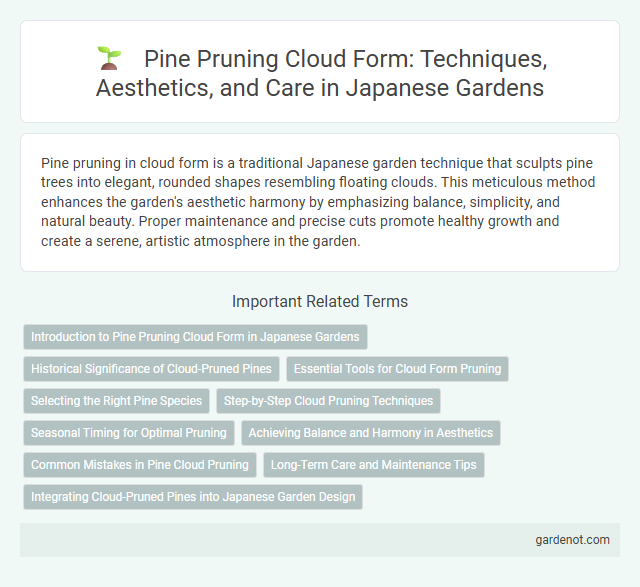Pine pruning in cloud form is a traditional Japanese garden technique that sculpts pine trees into elegant, rounded shapes resembling floating clouds. This meticulous method enhances the garden's aesthetic harmony by emphasizing balance, simplicity, and natural beauty. Proper maintenance and precise cuts promote healthy growth and create a serene, artistic atmosphere in the garden.
Introduction to Pine Pruning Cloud Form in Japanese Gardens
Pine pruning in the cloud form, known as "Niwaki," is a traditional Japanese gardening technique that shapes pine trees into rounded, cloud-like structures. This method emphasizes balance, harmony, and the natural aesthetic of the tree, embodying Zen principles and enhancing garden tranquility. Mastery of pine pruning requires precise cuts to encourage healthy growth while controlling the silhouette for seasonal beauty.
Historical Significance of Cloud-Pruned Pines
Cloud-pruned pines, a hallmark of traditional Japanese gardens, embody centuries-old horticultural artistry that reflects Zen Buddhist aesthetics and principles of balance and harmony. This meticulous pruning technique dates back to the Muromachi period (14th-16th century), symbolizing the spiritual cultivation and controlled simplicity valued in Japanese culture. Preserving these sculpted trees in gardens like Kenrokuen and Ritsurin highlights their enduring cultural and historical significance in Japan's landscape design heritage.
Essential Tools for Cloud Form Pruning
Essential tools for cloud form pruning in Japanese gardens include sharp shears, concave branch cutters, and a sturdy pole pruner. These tools enable precise cuts necessary to shape pine trees into the distinctive, layered "cloud" shapes. Maintaining tool sharpness and cleanliness ensures healthy growth and crisp, elegant forms.
Selecting the Right Pine Species
Selecting the right pine species is crucial for achieving the elegant cloud pruning form in a Japanese garden, with Japanese Black Pine (Pinus thunbergii) and Japanese White Pine (Pinus parviflora) being the most preferred varieties. These species respond well to pruning, allowing precise shaping of layered, rounded foliage pads that mimic clouds. Their adaptability and aesthetic appeal make them ideal for maintaining the traditional, serene look of a handcrafted Japanese garden.
Step-by-Step Cloud Pruning Techniques
Cloud pruning of pine trees in Japanese gardens involves meticulous step-by-step techniques to achieve the characteristic layered, cloud-like appearance. Begin by carefully thinning branches to define individual cloud layers, removing inward-growing shoots and crowded limbs to enhance air circulation and light penetration. Shape each cluster by selectively trimming needles and minor branches while maintaining the overall silhouette and balance of the pine tree.
Seasonal Timing for Optimal Pruning
Pine pruning in cloud form is best performed during early spring, before new growth begins, to shape the clouds and control density effectively. Late winter dormancy ensures minimal stress on the tree while allowing precise cuts to enhance the structure and aesthetic balance. Avoid pruning in late summer or fall to prevent stimulating vulnerable new growth prone to winter damage.
Achieving Balance and Harmony in Aesthetics
Pine pruning in the cloud form emphasizes meticulous shaping to create balanced, rounded layers resembling soft clouds, enhancing harmony within the Japanese garden's natural aesthetic. This technique prioritizes asymmetrical symmetry, maintaining organic flow while achieving visual equilibrium. Each pruned branch contributes to the overall rhythm, blending traditional artistry with nature's innate beauty.
Common Mistakes in Pine Cloud Pruning
Common mistakes in pine cloud pruning include excessive cutting that disrupts the tree's natural silhouette and uneven trimming that fails to create balanced cloud-like clusters. Neglecting proper branch spacing can result in dense, unhealthy foliage that diminishes the garden's aesthetic harmony. Maintaining consistent pruning techniques preserves the pine's elegant, sculpted appearance essential to traditional Japanese garden design.
Long-Term Care and Maintenance Tips
Pine pruning in cloud form requires regular maintenance to preserve its distinctive layered appearance and health. Use sharp, clean tools to selectively trim new growth in late spring and early summer, ensuring air circulation and light penetration to each branch layer. Applying balanced fertilizer twice a year and monitoring for pests like aphids or scale insects supports long-term vitality and aesthetic appeal.
Integrating Cloud-Pruned Pines into Japanese Garden Design
Cloud-pruned pines, with their sculpted, rounded foliage pads, create a distinct visual harmony in Japanese garden design by enhancing spatial depth and evoking natural landscapes in miniature form. Integrating these meticulously shaped trees emphasizes asymmetry and balance, key principles that guide the garden's tranquil and meditative atmosphere. Their organic shapes complement traditional elements such as stone lanterns, koi ponds, and mossy grounds, reinforcing the garden's aesthetic and spiritual symbolism.
Pine pruning cloud form Infographic

 gardenot.com
gardenot.com